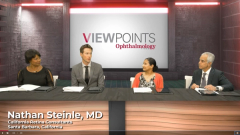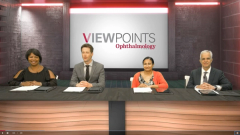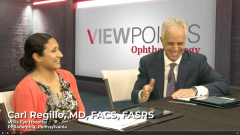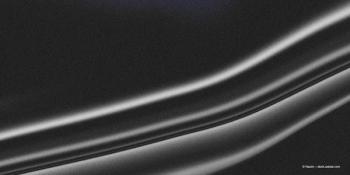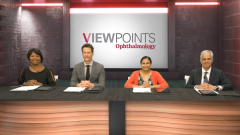
Emerging Therapies in Neovascular AMD and DME
Retina specialists review new and emerging treatments in neovascular AMD and DME, highlighting high-dose aflibercept and KSI-301.
Episodes in this series

Nathan Steinle, MD: We’ll move on now to emerging therapies. One exciting thing that drew me to becoming a retina specialist, and I’m sure all of you too, is that our field just keeps changing. It’s amazing. On the horizon, Dr Regillo, regarding high-dose aflibercept, instead of the standard 2 mg dosing, they’re prescribing 8 mg dosing. Can you talk us through a little bit about the protocols going forward and what your thoughts are on high-dose aflibercept?
Carl Regillo, MD, FACS, FASRS: Sure. It should say changing for the better.
Nathan Steinle, MD: That’s true.
Carl Regillo, MD, FACS, FASRS: Getting better, longer lasting therapeutics for both neovascular AMD [age-related macular degeneration] and DME [diabetic macular edema] and that’s a lot of what’s in the pipeline. And that includes on the top of the list because in the very near future, the potential approval of high-dose or 8 mg of aflibercept, quadruple dose, 2 mg is what we’ve been using of course on the label in practice. The drug at this dose was tested for both neovascular AMD and DME in the PULSAR and PHOTON studies. These were phase 3 registration studies, and they met their primary end point, which was noninferiority. The noninferior visual acuity gains compared to a standard 2 mg dose of aflibercept on the label, which means after the load, every 8 weeks for both diseases. And in the high-dose arms of the 2 studies, we’re able to dose up to 12-week intervals or 16-week intervals. Every time we get a new drug and a new study, the study design is always a bit different. So it can get a little complicated.
But to make it rather simple, I’ll say successful studies met the primary end point of being noninferior. And in those extended-dosing high-dose arms we saw fairly impressive percentages of patients being treated at the primary end point every 12 weeks or 16 weeks. Again, suggesting greater durability compared to 2 mg. And in the wet AMD study it was about 80% of patients were 12 weeks or 16 weeks in that range. The DME was even better, around 90% or around the 12-week to 16-week range. And again, based on the study design of disease activity criteria being used—every study is slightly different—but nonetheless, it gives us the impression of a drug that doesn’t give you better vision gains but seems to last longer and with a good safety profile. That’s key as we’ve talked about earlier about anything new that gets introduced.
So intraocular inflammation rates and other adverse events were very comparable between the old-fashioned, standard 2 mg and the new aflibercept at 8 mg. Interestingly, this was tried with ranibizumab [Lucentis] in the HARBOR study’s quadruple dose. And there were hints that you got a little better durability in the PRN [pro re nata] arms but nothing, I would say, clinically meaningful enough to pursue that dose. But this is looking different. And so, this has the potential to be FDA-approved in our hands for both indications this year.
Nathan Steinle, MD: All right, we’ll move off-topic now. We’ll go to a different set of molecules. We were only small for a long time in retina and now we’re talking about these large conjugates, these 1000-kilodalton conjugates. One is KSI-301. Can you tell me a little bit about that platform and what your thoughts are?
Prethy Rao, MD, MPH: Yes, it seems like this drug is a go big or a go home drug.
Nathan Steinle, MD: Right.
Prethy Rao, MD, MPH: It’s interesting. It’s an ABC, an antibody biopolymer conjugate. And so basically, the molecule itself is an IgG [immunoglobulin G] antibody that’s large and that’s combined with a biopolymer. And the idea is to provide durability for 2 different reasons. One is with a high molecular weight, which is this drug is 950 kilodaltons compared to way less in the other medications that we were talking about earlier. And the second is, is a higher dose. So those combination of things is what this molecule is trying to achieve.
And so, the DAZZLE and DAYLIGHT studies, mainly the DAZZLE study initially was a phase 2/3 study that demonstrated 3 loading doses of this KSI-301 study followed by an extension to 3-, 4-, and 5-month marks compared to ranibizumab on its own label use. And the results were promising but the primary objective was to look at the mean change in visual acuity and they did not achieve a noninferior result. It’s a little disappointing from that standpoint, I think, for everyone because we were excited about this molecule.
But, if you look at the fine print, a lot of these patients, I think Dr Regillo you mentioned this in some prior talks, is about 60% of the patients still end up getting to the 5-month mark with this medication. So that is still a good number of patients that are being treated out to this 5-month mark. The other thing that they did mention though was about 3% of their patients did have IOI [intraocular inflammation] events. It’ll be interesting to see how that translates going forward. So the DAYLIGHT study in contrast is looking at monthly doses of this medication compared to the aflibercept on the label. So, it’d be interesting to see what those results show.
Nathan Steinle, MD: Yes. Stay tuned.
Transcript edited for clarity
Newsletter
Keep your retina practice on the forefront—subscribe for expert analysis and emerging trends in retinal disease management.



